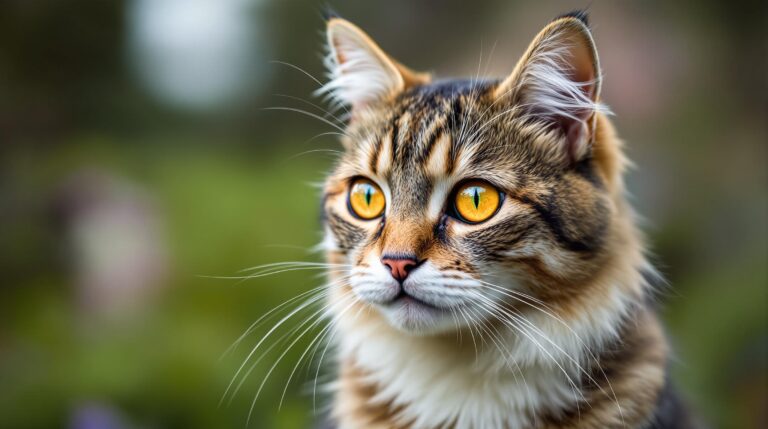Cats upper respiratory infection (URI) is a common health issue that can significantly impact your feline friend’s well-being. At Cat Karma Creations, we understand the importance of keeping your cat healthy and happy. This article will guide you through the symptoms, causes, and treatments of cat URI, helping you provide the best care for your pet. Discover how to recognize the signs early, explore effective treatment options, and learn preventive measures to keep your cat healthy. By the end, you’ll be equipped with the knowledge to manage and prevent URI in your beloved cat.
Symptoms of Cats Upper Respiratory Infection
Common Symptoms
The most common symptoms of cats upper respiratory infection include sneezing, coughing, and a runny nose. These symptoms are often the first signs that your cat might be suffering from URI. Sneezing can be frequent and forceful, and you might notice your cat sneezing out clear or colored mucus. Coughing, while less common, can also indicate a respiratory issue. Additionally, a cat runny nose can be a telltale sign, with discharge that may range from clear to yellow or green. If you notice these symptoms, feel free to reach out to us at our contact form for more information.
Less Common Symptoms
Less common symptoms of cat upper respiratory infection include eye discharge, fever, and lethargy. Cat eye discharge can be watery or thick and may be accompanied by redness or swelling. A fever can cause your cat to feel warm to the touch and may be accompanied by a loss of appetite. Lethargy, or a lack of energy, can also be a sign that your cat is not feeling well and may need veterinary attention. If you notice any of these symptoms, it’s important to seek professional help. You can also follow us on Facebook for more tips and updates.
When to Seek Veterinary Help
If you notice any of the symptoms mentioned above, it’s important to seek veterinary help promptly. Early diagnosis and treatment can significantly improve your cat’s recovery time and prevent the infection from worsening. If your cat is experiencing severe symptoms such as difficulty breathing, persistent fever, or a complete loss of appetite, it’s crucial to take them to the vet immediately. These symptoms can indicate a more serious condition that requires immediate attention. For more information, visit our website at Cat Karma Creations.
Causes of Cats Upper Respiratory Infection
Viral Causes
One of the primary causes of cat upper respiratory infection is viral infections. Common viruses that can lead to URI in cats include the Herpesvirus and Calicivirus. These viruses can cause a range of symptoms, from mild to severe, and are highly contagious. Herpesvirus can lead to symptoms such as sneezing, fever, and eye discharge, while Calicivirus can cause coughing, sneezing, and oral ulcers. Vaccination is an essential preventive measure against these viral infections. At Cat Karma Creations, we support cat welfare and encourage regular vaccinations to protect your furry friend.
Bacterial Causes
Bacterial infections are another common cause of cats upper respiratory infection. Bacteria such as Bordetella and Chlamydia can cause symptoms like sneezing, coughing, and nasal discharge. These bacteria can be spread through direct contact with infected cats or contaminated environments. Antibiotics are often necessary to treat bacterial infections, and maintaining good hygiene practices can help prevent their spread. We offer a range of cat-themed jewelry and gifts, including the Paw Print Charm Bracelet, which can be a thoughtful gift for cat lovers who want to show their support.
Environmental Factors
Environmental factors can also contribute to the development of cat upper respiratory infection. Factors such as stress, poor ventilation, and exposure to irritants like cigarette smoke or cleaning chemicals can weaken a cat’s immune system, making them more susceptible to infections. Ensuring a clean, stress-free environment is crucial for preventing URI in cats. Regular cleaning, proper ventilation, and avoiding exposure to irritants can help keep your cat healthy. At Cat Karma Creations, we believe in creating a harmonious environment for your feline friend, and our Cat Pose Yoga Block can be a great addition to your cat’s daily routine.
Treatment Options for Cats Upper Respiratory Infection
Medications and Antibiotics
The treatment for cat upper respiratory infection often depends on the underlying cause. For viral infections, supportive care and antiviral medications may be prescribed. For bacterial infections, antibiotics such as doxycycline or azithromycin are commonly used. It’s important to follow your veterinarian’s advice and complete the full course of medication to ensure a full recovery. Supportive care, such as providing a warm and comfortable environment, can also help your cat feel better. At Cat Karma Creations, we understand the importance of a comfortable and safe space for your cat, and our Meditation Cushion with Cat Design can provide a cozy spot for your cat to rest and recover.
Home Remedies and Supportive Care
In addition to medications, there are several home remedies and supportive care measures you can use to help your cat recover from cat upper respiratory infection. Using a humidifier or steam therapy can help relieve congestion and make breathing easier. Ensuring your cat stays hydrated is also crucial, as dehydration can worsen symptoms. Offering soft, moist food can make it easier for your cat to eat and maintain their energy levels. Gentle petting and comforting can also help reduce stress and promote healing. For more tips on supportive care, visit our Cat Themed Jewelry page for inspiration on creating a relaxing environment for your cat.
Veterinary Interventions
In some cases, veterinary interventions may be necessary to manage cat upper respiratory infection. Your vet may recommend additional tests to determine the exact cause of the infection and the best course of treatment. These tests can include blood work, nasal swabs, and X-rays. If your cat is severely dehydrated, they may need intravenous fluids to help them recover. In severe cases, hospitalization may be required to provide more intensive care and monitoring. For more information on veterinary care, you can follow us on Instagram.
Preventing Cats Upper Respiratory Infection
Vaccination
Vaccination is one of the most effective ways to prevent cat upper respiratory infection. Vaccines can protect your cat against common viruses like Herpesvirus and Calicivirus, which are major causes of URI. Regular vaccination, as recommended by your veterinarian, can help reduce the risk of infection and the severity of symptoms if your cat does become infected. It’s important to keep your cat’s vaccinations up to date to ensure maximum protection. At Cat Karma Creations, we support cat welfare and encourage regular vaccinations to protect your furry friend. You can also visit our All Jewelry page for unique and thoughtful gifts for cat lovers.
Hygiene Practices
Maintaining good hygiene practices is crucial for preventing cat upper respiratory infection. Regular cleaning of your cat’s living area, including their bedding, litter box, and food bowls, can help reduce the spread of bacteria and viruses. Using mild, pet-safe cleaning products can help keep your cat’s environment clean without causing irritation. Regular grooming can also help remove any dirt or debris that may be harboring germs. By keeping your cat and their environment clean, you can significantly reduce the risk of URI. For more tips on hygiene practices, visit our Nature Inspired page for inspiration on creating a clean and natural environment for your cat.
Quarantine New Cats
If you have a multi-cat household, it’s important to quarantine new cats before introducing them to your existing pets. This can help prevent the spread of cat upper respiratory infection and other contagious diseases. Keep new cats in a separate room for a few weeks and monitor them for any signs of illness. If you notice any symptoms, take them to the vet for a check-up before introducing them to your other cats. This simple step can help protect your entire feline family. For more information on introducing new cats, visit our Sterling Silver page for unique and thoughtful gifts for cat lovers.
Popular Quote
“A cat improves the garden wall in sunshine and the hearth in rain.” – William Butler Yeats
Statistical Fact
According to the American Veterinary Medical Association, approximately 80% of cats will experience at least one upper respiratory infection in their lifetime. This statistic underscores the importance of early detection and proper care to ensure your cat’s well-being. For more information, visit AVMA.
Three Tips for Managing Cats Upper Respiratory Infection
- Keep the Environment Clean: Regular cleaning and proper ventilation can help reduce the risk of URI. Use pet-safe cleaning products and ensure your cat’s living area is free from irritants.
- Monitor for Symptoms: Early detection is key. Keep an eye out for common symptoms like sneezing, coughing, and runny nose, and consult a vet if you notice any signs of illness.
- Provide Supportive Care: Use a humidifier, ensure your cat stays hydrated, and offer soft, moist food to help your cat feel more comfortable and recover faster.
Popular Questions About Cats Upper Respiratory Infection
- What are the most common symptoms of cat URI? The most common symptoms include sneezing, coughing, and a runny nose. Less common symptoms can include eye discharge, fever, and lethargy.
- How can I prevent URI in my cat? Regular vaccinations, maintaining good hygiene, and quarantining new cats can help prevent URI. Ensure your cat’s environment is clean and stress-free.
- When should I take my cat to the vet for URI? If your cat shows severe symptoms such as difficulty breathing, persistent fever, or a complete loss of appetite, it’s important to seek veterinary help immediately.
- What are the treatment options for cat URI? Treatment options include medications, antibiotics, and supportive care. Your vet may also recommend additional tests to determine the exact cause of the infection.
- Can URI be contagious to other cats? Yes, URI is highly contagious, especially in multi-cat households. Quarantine new cats and keep your existing pets’ environment clean to prevent the spread.
Final Thoughts About cats upper respiratory infection
Cats upper respiratory infection can be a challenging condition, but with early recognition and proper care, your feline friend can recover quickly. By understanding the symptoms, causes, and treatment options, you can provide the best possible care. Remember to maintain good hygiene and consider preventive measures like vaccination to keep your cat healthy. If you suspect your cat has URI, consult a veterinarian for a proper diagnosis and treatment plan. At Cat Karma Creations, we are here to support you and your feline friend. For more information, visit our website at Cat Karma Creations or contact us at (800) 343-1604 or info@catkarmacreations.com.
| Feature | Viral Infections | Bacterial Infections | Fungal Infections |
|---|---|---|---|
| Common Causes | Herpesvirus, Calicivirus | Bordetella, Chlamydia | Aspergillus, Candida |
| Symptoms | Sneezing, coughing, fever | Sneezing, coughing, nasal discharge | Sneezing, coughing, eye discharge |
| Treatment | Supportive care, antivirals | Antibiotics, supportive care | Antifungals, supportive care |
| Prevention | Vaccination, hygiene | Hygiene, antibiotics | Hygiene, antifungals |
| Contagiousness | Highly contagious | Moderately contagious | Less contagious |
- Understand the common causes of cat upper respiratory infections, such as viruses and bacteria.
- Recognize the symptoms of cat URI, including sneezing, coughing, and nasal discharge.
- Learn about the different treatment options, from antibiotics to home remedies.
- Explore preventive measures, such as vaccination and maintaining good hygiene.
- Understand the contagious nature of cat URI and how to prevent the spread to other cats.
- Discover the importance of early diagnosis and prompt veterinary care for effective treatment.
















